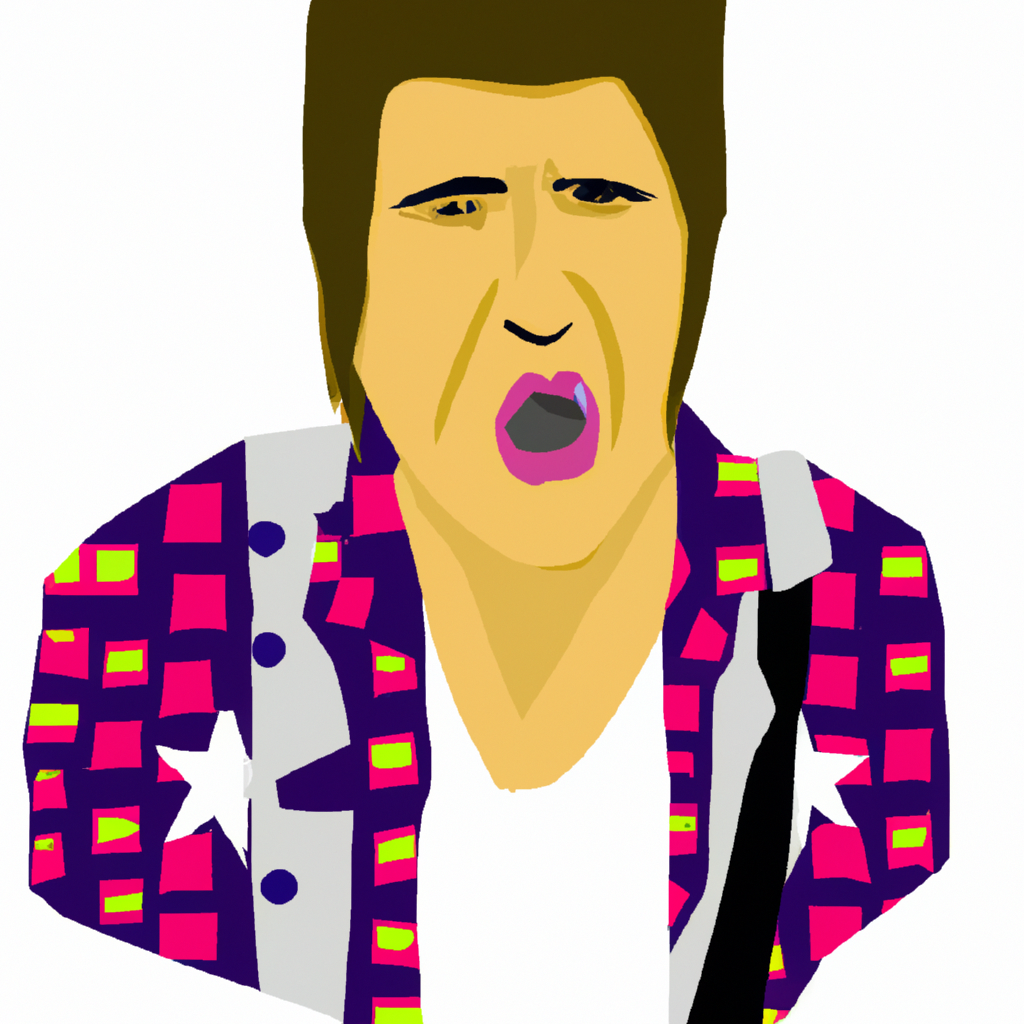
I. Introduction
A. Definition of rock and roll
Rock and roll is a genre of popular music that emerged in the early 1950s. Its roots can be traced back to African-American rhythm and blues music and country music. The genre is characterized by a strong backbeat, electric guitars, and vocal harmonies. It is known for energetic live performances and has been associated with a rebellious spirit.
B. Brief history of its origins
The origins of rock and roll can be traced back to the 1940s and 1950s. African-American blues music and country music were two of the biggest influences on early rock and roll. The blues provided the foundation for the genre, with artists like Muddy Waters and Howlin’ Wolf inspiring early rock and roll musicians. Country music also played a significant role, as artists like Hank Williams and Bill Monroe influenced many early rock and roll musicians with their simple, catchy melodies and relatable lyrics.
In the early 1950s, artists like Chuck Berry and Little Richard began to emerge, blending elements of blues and country music with a new, electric sound. Elvis Presley, however, is often credited with being the artist who brought rock and roll to the mainstream. His energetic performances and controversial performances on television helped to popularize the genre around the world. By the mid-1950s, rock and roll had become a cultural phenomenon and was influencing everything from fashion to movies.
In the 1960s, rock and roll continued to evolve, with the British Invasion bringing new sounds and new ideas to the genre. Bands like The Beatles and The Rolling Stones dominated the charts, with their catchy melodies and cheeky lyrics. The psychedelic era of the late 1960s brought a new focus on experimentation and pushing boundaries, with bands like The Doors and Jimi Hendrix embracing new, mind-altering sounds and visuals.
The 1970s saw the rise of heavy metal, with bands like Led Zeppelin and Black Sabbath pushing the genre to new heights of volume and intensity. Punk rock emerged as a rebellious response to the excesses of the 1970s, with bands like The Ramones and The Sex Pistols rejecting the bloated rock star image in favor of a raw, stripped-down sound.
The 1980s saw the emergence of a new wave of rock, with the rise of glam metal and thrash metal. At the same time, alternative rock began to gain popularity, with bands like R.E.M. and The Replacements experimenting with new sounds and themes. By the 1990s, grunge had taken over, with bands like Nirvana and Pearl Jam dominating the airwaves and signaling a return to the raw energy of early rock and roll.
Despite the many changes and transformations that rock and roll has undergone over the years, it remains a vital and influential force in popular culture. Its legacy can be heard in everything from hip hop to electronic music, and it continues to inspire new generations of musicians and fans.

II. Early Influences
Rock and roll has its roots in various music genres, including blues, country, and gospel. The combination of these genres creates a unique sound that distinguishes rock and roll from other styles of music.
A. Blues origins
Blues music originated in the Deep South during the late 19th century. It emerged as a form of expression for African Americans who suffered from poverty and discrimination. The music was characterized by its soulful vocal style and guitar-driven melodies. Its lyrics often dealt with the harsh realities of life, such as poverty, heartbreak, and racism.
Blues had a significant influence on the development of rock and roll. Early rock and roll artists, such as Chuck Berry and Little Richard, borrowed heavily from the blues. They infused it with electric instruments and loud amplifiers, creating a more energetic and electrifying sound.
B. Country music influences
Country music also played a crucial role in shaping rock and roll. It emerged in rural areas of the southern United States and was associated with cowboys and western culture. Country music featured simple melodies, acoustic instruments, and lyrics that celebrated rural life.
Some of the earliest rock and roll songs were essentially country songs with a faster tempo and electric instruments. Elvis Presley, often referred to as the “King of Rock and Roll,” was heavily influenced by country music. He blended country and blues to create a unique sound that took the world by storm.
C. Gospel music influences
Gospel music played a significant role in the development of rock and roll as well. It emerged in African American churches and featured soulful vocals, call and response, and powerful lyrics about spirituality and faith.
Many early rock and roll artists, such as Little Richard and Jerry Lee Lewis, came from a gospel background. They infused their music with gospel influences, such as hand claps, foot stomps, and call-and-response vocals.
In conclusion, the early influences on rock and roll were diverse, ranging from the soulful blues to the simple yet powerful country music and the spiritual and uplifting gospel music. These genres helped shape the sound and style of early rock and roll and continue to influence it today. The combination of these influences created a unique sound that has captivated audiences for decades.
III. The Birth of Rock and Roll
A. Chuck Berry’s influence
Chuck Berry is often referred to as the “Father of Rock and Roll.” He was a blues guitarist who in the early 50s began incorporating elements of rhythm and blues into his music. Berry’s guitar solos and song lyrics were energetic and rebellious, which appealed to young people at the time. He had a string of hits in the mid-50s with songs like “Maybellene,” “Roll Over Beethoven,” and “Johnny B. Goode.” His music was a major influence on many of the rock and roll musicians who would come after him.
B. Elvis Presley’s impact
Elvis Presley is probably the most well-known figure in rock and roll history. His impact on the genre cannot be overstated. Presley began his music career in the mid-50s and quickly became a sensation. His Elvis Presley’s unique style blended elements of country, blues, and pop music, and his live performances were electrifying. Presley’s music, image, and personality embodied the rebellious spirit of rock and roll, making him an icon of the genre. Hits like “Hound Dog,” “Jailhouse Rock,” and “All Shook Up” cemented his status as an important figure in rock history.
C. The Rock and Roll Revolution
Rock and roll music was more than just a new genre. It was a cultural phenomenon that swept the nation, and eventually the world. Young people everywhere were drawn to the energy and excitement of rock and roll. It was a way for them to rebel against the conservative values of their parents’ generation. The music had a rawness and passion that connected with people on a deep level. With the rise of rock and roll came a new era of youth culture. It was a time of change and experimentation, with young people exploring new ideas and pushing boundaries. The rock and roll revolution was not just a musical movement, but a social and cultural one as well.
IV. The British Invasion
In the early 1960s, the world was introduced to a new wave of rock and roll music coming out of Great Britain. This movement is famously known as the British Invasion. The Beatles and The Rolling Stones were at the forefront of this era, and they took American rock and roll by storm, capturing the hearts and minds of millions of young people across the world.
A. The Beatles
The Beatles’ arrival in the United States in 1964 marked the peak of the British Invasion. They had already become a sensation in England with their unique sound, which blended pop, rock, and blues influences. Their energetic performances and charismatic personalities quickly made them a sensation in America. They appeared on The Ed Sullivan Show, which drew a record-breaking 73 million viewers. From then on, their music and message of love and positive change had a profound impact on the youth culture. Some of their most iconic songs like “I Want to Hold Your Hand,” “Hey Jude,” and “Let it Be” went on to become classics of rock and roll.
B. The Rolling Stones
Another British band that contributed to the British invasion was The Rolling Stones. The group was formed in London in 1962 and soon gained a reputation for their raw, blues-inspired sound. They were seen as rebels at the time, with their scrappy appearances and provocative lyrics. Despite not being as musically polished as The Beatles, The Rolling Stones’ attitude and style captured the public’s imagination. They are known for their hit songs such as “Satisfaction,” “Sympathy for the Devil,” and “Jumpin’ Jack Flash.”
C. Other British Bands
Apart from The Beatles and The Rolling Stones, there were many other notable bands that were part of this era. These included The Kinks, The Who, and The Animals, among others. Each of these bands had their unique style and sound, but they all shared the same spirit of rebellion and youthful energy. They had a profound influence on the development of rock and roll in the 1960s and beyond.
In conclusion, the British invasion was a significant turning point in the history of rock and roll. It brought a new wave of musical ideas and artists to the forefront, ushering in a new era of rock and roll music. The Beatles and The Rolling Stones’ impact continues to be felt in modern-day music, and the British Invasion remains a vital part of rock and roll history.
V. The Psychedelic Era
The Psychedelic Era of rock and roll in the late 1960s was a time of experimentation and innovation, as musicians embraced the counterculture movement and sought to create a new sound that reflected the changing social and political landscape of the time.
One of the most iconic figures of the era was Jimi Hendrix, whose innovative guitar playing and flamboyant stage presence captured the spirit of the time. His debut album, “Are You Experienced?” was a testament to his talent and creativity, featuring psychedelic rock anthems such as “Purple Haze” and “Hey Joe.” Hendrix’s tragic death in 1970 brought an end to his short but influential career, but his impact on rock music is still felt today.
Another band that defined the Psychedelic Era was The Doors, led by the charismatic frontman Jim Morrison. Known for his provocative lyrics and wild stage antics, Morrison embodied the rebellious spirit of the era. The Doors’ self-titled debut album featured hits such as “Light My Fire” and “Break on Through” and pushed the boundaries of rock music with its fusion of psychedelic, blues, and jazz influences.
Perhaps the most iconic event of the Psychedelic Era was the Woodstock festival, held in August 1969. The festival was a celebration of peace, love, and music, and attracted over 400,000 people to Max Yasgur’s farm in upstate New York. The three-day event featured performances by some of the biggest names in rock and roll, including Jimi Hendrix, The Who, Janis Joplin, and Santana. It was a defining moment in the history of rock music and a symbol of the counterculture movement’s ideals.
Overall, the Psychedelic Era was a time of significant cultural and musical change, and its influences can still be felt in contemporary rock music. Hendrix, The Doors, and Woodstock remain symbols of this dynamic and innovative era, representing the spirit of experimentation and creative freedom that defined it.
VI. The Rise of Heavy Metal
During the late 1960s and early 1970s, a new sound had emerged that was even heavier, louder and more intense than the rock music of the time. This sound was Heavy Metal, a genre that required a higher level of musical virtuosity and technical skill than rock music. Heavy Metal was also known for its loudness, its aggressive sound and its often-controversial lyrics.
A. Led Zeppelin
One of the pioneers and most influential bands in the Heavy Metal genre is Led Zeppelin. The band consisted of Jimmy Page on guitar, John Bonham on drums, John Paul Jones on bass and keyboards, and Robert Plant on vocals. Led Zeppelin was known for their heavy, bluesy sound, complex guitar riffs, and intricate drumming. The band’s popularity skyrocketed in the 1970s, and their songs, such as “Stairway to Heaven” and “Kashmir” are still considered classics of Heavy Metal.
B. Black Sabbath
Another highly influential Heavy Metal band was Black Sabbath. Founded in Birmingham, England in 1968, the band consisted of Ozzy Osbourne on vocals, Tony Iommi on guitar, Geezer Butler on bass, and Bill Ward on drums. Black Sabbath is often cited as the pioneers of the Heavy Metal genre, with their dark, brooding sound, and occult-inspired lyrics. Songs such as “Iron Man” and “Paranoid” and the self-titled album “BLACK SABBATH” are considered to be milestones in Heavy Metal history.
C. Deep Purple
Deep Purple was another leading Heavy Metal band of the 1970s. The band consisted of Ritchie Blackmore on guitar, Jon Lord on keyboards, Ian Paice on drums, Ian Gillan on vocals, and Roger Glover on bass. The band’s hard rock and blues-influenced sound is evident in songs such as “Smoke on the Water” and “Highway Star”. Deep Purple’s influence on Heavy Metal is undoubted, with Blackmore’s innovative guitar work inspiring countless heavy metal guitarists.
Conclusion:
The rise of Heavy Metal in the 1970s marked a turning point in the history of Rock and Roll. Led Zeppelin, Black Sabbath and Deep Purple paved the way for the Heavy Metal genre not only with their musicianship and songwriting but also with their influence on future generations of Heavy Metal musicians. The genre would continue to evolve throughout the decades with more and more bands emerging and the sound constantly evolving. Heavy Metal remains a vital and strong genre to this day.
VII. Punk Rock
Punk Rock emerged in the mid to late 1970s, as a response to the mainstream and commercialization of rock music. It was a rebellion against the status quo, a product of its creators’ frustrations and dissatisfaction with the world around them. At the heart of Punk Rock was the belief that rock music should be simple, straightforward, and honest, rejecting the gimmicks, theatrics, and excesses of mainstream rock.
The Ramones were the poster boys of Punk Rock, epitomizing the genre’s simplicity and raw energy. They played fast, three-chord songs, with catchy melodies and lyrics that sometimes defied conventional songwriting rules. With songs like “Blitzkrieg Bop” and “Sheena is a Punk Rocker,” The Ramones captured the spirit of rebellion and nonconformity that Punk Rock was all about. Their influence can still be felt in bands today, and they continue to be revered as one of the most important bands in rock history.
The Clash, on the other hand, were more politicized than The Ramones. Their music was still fast and catchy, but their lyrics dealt with social and political issues, including racism, poverty, and the state of the world. They were also known for experimenting with different genres, including reggae, funk, and rockabilly. Their seminal album, “London Calling,” is widely considered one of the greatest albums of all time, and their impact on punk and beyond cannot be overstated.
The Sex Pistols were the most controversial of the three, known for their shock tactics, confrontational attitude, and explicit lyrics. Their debut album, “Never Mind the Bollocks, Here’s the Sex Pistols,” was a scathing critique of the British establishment, and their public appearances often resulted in riots and chaos. While their time as a band was short-lived, their influence was immense, and their legacy continues to this day.
Punk Rock was more than just a musical genre; it was a cultural movement that challenged the existing norms of society. The Ramones, The Clash, and The Sex Pistols were just a few of the bands that defined this movement, and their impact on rock music and popular culture cannot be understated. Punk Rock paved the way for countless other sub-genres of rock, and its spirit of rebellion and nonconformity continues to inspire new generations of musicians and fans alike.
VIII. The 1980s
During the 1980s, rock music took on many sub-genres that would eventually impact the sound of rock in different ways. Three of the most popular sub-genres were glam metal, thrash metal, and alternative rock.
Glam metal, also known as ‘hair metal,’ is a form of rock music that incorporated theatrics and aesthetics, including the use of makeup and spandex. Popular bands during this time were Mötley Crüe, Poison, and Bon Jovi. They were known for their high energy and catchy choruses, often featuring the use of power ballads. The style of glam metal had a significant impact on pop culture, influencing fashion, and television shows such as MTV’s Headbangers Ball.
Thrash metal, on the other hand, was a sub-genre of heavy metal that emerged during the 1980s. It was characterized by fast tempos, aggressive guitar riffs, and harsh lyrics. Metallica, Megadeth, and Slayer were some of the influential bands of the era. Thrash metal was seen as a response to the more commercial metal that was dominant during the time, and its influence would extend into later decades.
Alternative rock, meanwhile, was the catch-all term for the bands that created rock outside of mainstream commercial rock. Its roots can be traced back to punk rock, new wave, and post-punk. Bands like R.E.M., The Smiths, and The Cure were prominent in the development of alternative rock, with their unapologetic use of experimentation and lyrics that were often introspective, political, and socially conscious. Alternative rock would go on to be a key influence in the grunge and indie rock movements in the following decade.
In summary, the 1980s was a decade of experimentation and diversity in rock music. Glam metal, thrash metal, and alternative rock, in particular, highlighted the different directions that rock could take, and helped to shape the sound of rock in the subsequent decades.
IX. The Grunge Explosion
Grunge music emerged in the late 1980s and early 1990s as a response to the polished, commercial sounds of mainstream rock music. It originated in Seattle, Washington, where young bands like Soundgarden, Pearl Jam, and Nirvana gained popularity. These bands created a raw, unpolished sound that was characterized by heavy guitar riffs and introspective lyrics.
A. Nirvana
Nirvana was perhaps the most iconic and influential grunge band of all time. They burst onto the scene in 1991 with their hit album “Nevermind,” which featured the now-iconic track “Smells Like Teen Spirit.” The album went on to sell millions of copies and introduced a whole new generation of music fans to the raw, emotive sounds of grunge music.
Nirvana’s lyrics spoke to a generation of disaffected, disillusioned young people who felt alienated from mainstream society. Lead singer Kurt Cobain, who tragically died in 1994, was known for his tortured, introspective lyrics and his powerful, gravelly voice. His unique songwriting style and charismatic stage presence helped to define the grunge sound and inspired countless other musicians in the years to come.
B. Pearl Jam
Pearl Jam was another influential grunge band from Seattle. Like Nirvana, they were known for their raw, emotionally charged sound and introspective lyrics. However, their music was also characterized by a more melodic, riff-driven style that set them apart from many of their grunge peers.
Pearl Jam’s debut album, “Ten,” was released in 1991 and quickly became a hit. It featured tracks like “Alive,” “Even Flow,” and “Jeremy,” all of which showcased the band’s powerful, anthemic sound. Lead singer Eddie Vedder’s distinctive voice and intense stage presence helped to solidify the band’s place as one of the most important grunge acts of the era.
C. Soundgarden
Soundgarden was a pioneering grunge band that emerged in the late 1980s. They were known for their heavy, riff-driven sound and the powerful vocals of lead singer Chris Cornell. Their 1994 album “Superunknown” was a critical and commercial success, featuring hits like “Black Hole Sun” and “Spoonman.”
Soundgarden’s music was characterized by a unique blend of metal and psychedelic influences, which helped to set them apart from many other grunge bands. Their heavy, guitar-driven sound proved highly influential, inspiring a new generation of musicians as well as fans.
In conclusion, the grunge explosion of the early 1990s represented a major shift in the landscape of popular music. Bands like Nirvana, Pearl Jam, and Soundgarden helped to redefine the parameters of rock music, creating a raw and emotive sound that spoke powerfully to a generation of young people. Despite the tragic loss of Kurt Cobain, the legacy of grunge music continues to influence and inspire new generations of musicians and fans to this day.
X. Conclusion
Rock and roll has been one of the most influential and enduring genres of music in the history of popular music. Its roots lie in the fusion of blues, country and gospel music in the 1950s. Since then, it has evolved to include various subgenres such as psychedelic rock, heavy metal, punk rock, alternative rock, and grunge. It has influenced countless musicians and shaped popular culture.
A. The Legacy of Rock and Roll
One of the most significant legacies of rock and roll is the way it changed the social landscape of the world. Rock and roll has been closely linked to social movements, representing rebellion against convention and the status quo. It has been used as a tool for social and political change, and has challenged the way people think about music and societal norms. Rock and roll music has also inspired fashion, art, and literature. It has been a symbol of youth culture, rebelliousness, and freedom.
Another important legacy of rock and roll is its impact on other genres of music. Rock and roll has influenced pop music, hip hop, electronic music, and other genres. It has also contributed to the growth of music industry, making it one of the largest industries in the world.
B. The Future of Rock Music
Many people have been predicting the death of rock music for decades. While the popularity of the genre has declined in recent years, there is no denying the impact that rock music has had on popular culture. It continues to inspire new generations of musicians and fans.
The future of rock music may lie in its ability to evolve and adapt. Rock bands are experimenting with new sounds and fusing rock with other genres to create something new. Many musicians are exploring new ways to use technology to create music. While the traditional concept of a rock band may be changing, the spirit of rock and roll will continue to inspire people.
In conclusion, rock and roll has had a profound impact on popular music and culture. Its legacy can be seen in the way it has changed the social landscape of the world and influenced music and other art forms. While the future of rock music may be uncertain, it is clear that the genre will continue to inspire musicians and fans for years to come.



